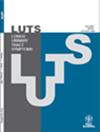Effectiveness of game-based core exercise in children with non-neuropathic bladder dysfunction and comparison to biofeedback therapy
Abstract
Objectives
This study was planned to evaluate the effectiveness of game-based core exercises in children diagnosed with non-neuropathic bladder dysfunction and compare this effectiveness to that of the biofeedback treatment method.
Methods
The study included 48 children, aged 6–13 years, who were diagnosed with non-neuropathic bladder dysfunction. The children satisfying the inclusion criteria were selected by drawing lots from the population with the method of nonprobability random sampling. The patients were divided into three groups: group I, “game-based core stabilization exercise training”; group II, “biofeedback program”; and group III, “game-based core stabilization exercise training in addition to the biofeedback program.” The Dysfunctional Voiding and Incontinence Symptom Scale (DVISS) scores and uroflowmetry values of the patients were evaluated before and after the treatment.
Results
The mean age of the participants was 8.81 ± 2.08 years. There was a statistically significant difference between the pretreatment and post-treatment DVISS scores in all three groups (p < .05). However, no significant difference was found among the groups. There was no statistically significant difference in the uroflowmetry results of the patients in group I and II before and after the treatment. In group III, the time to maximum flow rate after treatment was significantly reduced, and the average flow rate was significantly increased.
Conclusions
According to the results of this study, the use of game-based exercises along with biofeedback treatment may reduce DVISS scores in children with non-neuropathic bladder dysfunction. A combination of the two methods may have positively affected the uroflowmetry results of the patients. We think that game-based exercises will contribute to the literature as a new treatment option in the treatment of non-neuropathic bladder dysfunction.

 求助内容:
求助内容: 应助结果提醒方式:
应助结果提醒方式:


